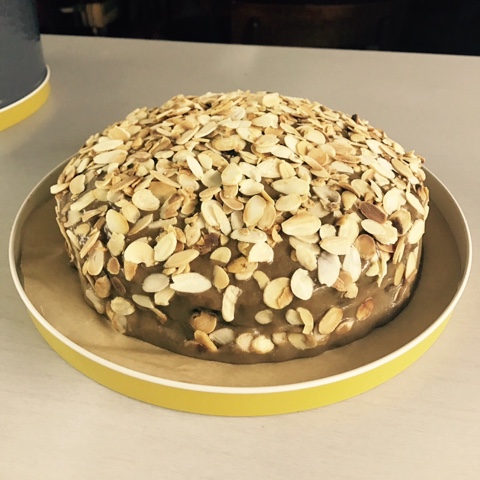The pastry and sweet filling recipes are adapted from 1970 cookbook Scandinavian Cooking for Pleasure, sourced from a secondhand bookshop/cafe/bar in a converted chapel in Broadstairs. Thankfully, it's one with photos, as some of the pastry designs are quite complicated. I've stuck with what they call 'snails', where the pastry is rolled into a swiss roll shape and cut into slices. I also got some tips and the savoury filling idea from Paul Hollywood's Bread book. Pretty sure Paul was alive in 1970 so that's fine...
Ingredients
Danish pastry
(Makes 20 snails)
250g unsalted butter
500g strong white bread flour
7g salt
2 tsp easy bake yeast
80g caster sugar
1 egg, beaten
260ml milk
Optional: 1 tsp of ground spices such as cardamom or cinnamon (depending on final flavours)
Cheese and mushroom filling
1 tbsp olive oil
1 small onion, finely chopped
100g mushrooms, finely chopped (I used portabella as they're a bit meatier than normal mushrooms)
6 slices emmentaal
Almond filling
50g flaked almonds
50g caster sugar
50g unsalted butter
3 drops vanilla extract
Method
1. Roll out the butter into a 30cm x 15cm rectangle by putting it between 2 sheets of greaseproof paper. Chill in the fridge until ready to use.
2. Mix the dry ingredients together (including any spices if using). Add the egg and most of the milk, and combine to make a soft dough. Add the rest of the milk if the dough doesn't come together. Knead on a lightly floured surface until smooth and shiny, then wrap and chill for about 2 hours.
3. Roll the dough into a 50cm x 20cm rectangle. Lay the sheet of butter over the top - it will be shorter than the dough, so move to one end and fold the unbuttered pastry over the butter, then fold the top third over that - you should have 3 layers of dough and 2 layers of butter. Seal the edges, wrap and chill for 15 minutes.
4. Roll the dough out to the original size, fold in 3 again, at right angles to the first folds, wrap and chill for another 15 minutes. Repeat twice more, then wrap and rest in the fridge for at least 15 minutes before shaping and filling. You can also leave the dough in the fridge overnight, or freeze at this point. If you cut the pastry in half, you should be able to see well defined layers.
5. To make the savoury filling, fry the onions in a little olive oil for a few minutes, then add the mushrooms and cook until soft. Season and cool before using to fill the pastries.
6. To make the sweet filling, blitz the almonds and sugar together to make a crumb-like texture, then add the vanilla extract and work in the butter. Chill until needed.
7. To fill the pastries, roll out half the dough into a 20cm x 30cm rectangle with the long side facing you - it will be quite stiff and takes some elbow grease! Also, have you noticed I can't roll a rectangle?! Spread the cooled savoury filling over the dough and top with the slices of cheese.
8. Roll into a Swiss roll by lifting the top corners and rolling towards you , keeping the pastry as tight as possible. Seal the join by pinching along the seam. Cut into 10 slices, each about 2cm thick, and place on a baking tray lined with greaseproof paper. Cover lightly with cling film and leave to prove for 30 minutes.
9. Roll out the remaining half of the pastry to the same size as above. Put the almond filling between 2 sheets of cling film and roll out to a slightly smaller size than the dough. Place over the top of the pastry and roll and slice as above. Place on a second lined baking tray and prove for 30 minutes. Preheat the oven to 180C
10. Glaze the pastries with beaten egg or milk and bake in the oven for 20 minutes until golden brown. I did get a bit of butter leakage, especially in the sweet pastries. Try and wait until they've cooled a little bit before eating.
The Bearded Argentnian rated these in my top 10 bakes, and I have checked that I've baked more than 10 things, so they must be pretty good. I thought they were so good, I swore out loud when I took the first bite...










































